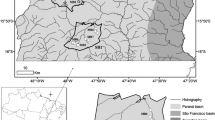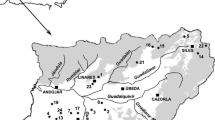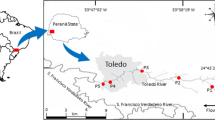Abstract
The influence of watershed land use on microzooplankton was examined. Six rivers and a shallow lake located in rural (agriculture, livestock) and urban areas were sampled during 4 weeks at low water, low temperatures and 3 weeks at high water, high temperatures. The major aim of this study was to analyze the composition, richness and abundance of the microzooplankton in relation to land use, taking into account nutrient concentration, biological oxygen demand (BOD5), conductivity, pH, transparency, dissolved oxygen, and chlorophyll-a. Redundancy analysis was used to assess microzooplankton response to environmental gradients. The composition and abundance can be considered good indicators of the land used and characteristic of the basin (broad range of conductivity water). The species composition show a gradient along the conductivity, pH and chlorophyll-a. Brachionus spp. were associated with saline waters on rural area and Keratella spp. (except Keratella tropica) were associated with urban water bodies. The microzooplankton abundance diminished by a factor of ten from the rivers in livestock–agriculture-dominated watersheds to those located in strictly urban areas. Urban rivers had low abundances of chlorophyll-a and microzooplankton despite the high concentration of nutrients. However, the effect of urbanization (mesotrophic/mesosaprobious state and lead presence) cannot be analyzed alone due to the potential effect of a filter-feeding invasive mollusk that colonizes the hard surfaces of harbor buildings and bridge pillars.





Similar content being viewed by others
References
Allan, J. D., & Flecker, A. S. (1993). Biodiversity conservation in running waters. Bioscience, 43, 31–43.
Amsler, M., Drago, E., & Paira, A. (2007). Fluvial sediments: main channel and floodplain interrelationships. In M. Iriondo, J. C. Paggi, & J. Parma (Eds.), The Middle Paraná River: limnology of subtropical wetland (pp. 123–141). Berlin: Springer.
Antoniolli, M. E. (2007). Calidad bacteriológica de los hidrosistemas naturales que circundan la ciudad de Santa Fe, Argentina. Tesina licenciatura saneamiento ambiental. Santa Fe: UNL.
APHA. (2005). Standard methods for the examination of water and wastewater. Washington: American Public Health Association.
Attayde, J. L., & Bozelli, R. L. (1998). Assesing the indicator properties of zooplankton assemblages to disturbance gradients by canonical correspondence analysis. Canadian Journal of Fisheries and Aquatic Sciences, 55, 1789–1797.
Baer, K. E., & Pringle, C. M. (2000). Special problems of urban river conservation: the encroaching megalopis. In P. J. Boon, B. R. Davis, & G. E. Potts (Eds.), Global perspectives on river conservation. London: John Wiley Sons.
Beaver, J. R., & Crisman, T. L. (1990). Use the microzooplankton as an early indicator of adevancing cultural eutrophication. Internationale Vereinigung für Theoretische und Angewandte Limnologie, 24, 532–537.
Boltovskoy, D., & Cataldo, D. H. (1999). Population of Limnoperna fortunei, an invasive fouling mollusc, in the Lower Paraná River. Biofouling, 13(3), 255–263.
Bonetto, A. A. (1976). Calidad de las aguas del río Paraná. Buenos Aires: INCYTH-PNUD.
Camargo, J. A., & Alonso, A. (2006). Ecological and toxicological effects of inorganic nitrogen pollution in aquatic ecosystems: a global assessment. Environment International, 32, 831–849.
Ciros-Perez, J., Gomez, A., & Serra, M. (2001). On the taxonomy of three sympatric sibling species of the Brachionus plicatilis (Rotifera) complex from Spain, with the description of B. ibericus n. sp. Journal of Plankton Research, 23, 1311–1328.
Claps, M. C., Gabellone, N., & Neschuk, N. C. (2009). Influence of regional factors on zooplankton structure in a saline lowland river: the Salado River (Buenos Aires Province, Argentina). River Research and Applications, 25, 453–471.
Derry, A. M., Prepas, E. E., & Hebert, P. D. N. (2003). A comparison of zooplankton communities in saline lakewater with variable anion composition. Hydrobiologia, 505, 199–215.
Dodson, S. I., & Lillie, R. A. (2001). Zooplankton communities of restored depressional wetlands in Wisconsin, USA. Wetlands, 21, 292–300.
Dodson, S. I., Lillie, R. A., & Will-Wolf, S. (2005). Land use, water chemistry, aquatic vegetation, and zooplankton community structure of shallow lakes. Ecological Applications, 15, 1191–1198.
Dodson, S. L. (2008). Biodiversity in southern Wisconsin storm-water retention ponds: correlations with watershed cover and productivity. Lake and Reservoir Management, 24, 370–380.
Dodson, S. L., Everhart, W. R., Jandl, A. K., & Krauskopf, S. J. (2007). Effects of watershed land use and lake age on zooplankton species richness. Hydrobiologia, 579, 393–399.
Duggan, I. C., Green, J. D., & Thomasson, K. (2001). Do rotifers have potential as bioindicators of lake trophic state? Internationale Vereinigung für Theoretische und Angewandte Limnologie, 27, 3497–3502.
Duggan, I. C., Green, J. D., & Shiel, R. J. (2001). Distribution of rotifers in North Island, New Zealand, and their potential use as bioindicators of lake trophic state. Hydrobiologia, 446(447), 155–164.
Duggan, I. C., Green, J. D., & Shiel, R. J. (2002). Distribution of rotifer assemblages and historical factors. Freshwater Biology, 47, 195–206.
Ejsmont-Karabin, J., & Kruk, M. (1998). Effects of contrasting land use on free-swimming rotifer communities of streams in Masurian Lake District, Poland. Hydrobiologia, 387(388), 241–249.
Faeth, S. H., Warren, P. S., Schochat, E., & Marussich, W. A. (2005). Trophic dynamics in urban communities. Bioscience, 55, 399–407.
Fontaneto, D., De Smet, W. H., & Ricci, C. (2006). Rotifers in saltwater environments, re-evaluation of an inconspicuous taxon. Journal of the Marine Biological Association (United Kingdom), 86, 623–656.
Gagneten, A. M., & Paggi, J. C. (2008). Effects of heavy metal contamination (Cr, Cu, Pb, Cd) and eutrophication on zooplankton in the lower basin of the Salado River (Argentina). Water, Air, and Soil Pollution, 198, 317–334.
Gannon, J. E., & Stemberg, R. S. (1978). Zooplankton (especially crustaceans and rotifers) as indicators of water quality. Transactions of the American Microscopical Society, 97, 16–35.
Garcia de Emiliani, M. O., & Anselmi de Manavella, M. I. (1989). Fitoplancton y variables ambientales en la cuenca del río Saladillo (Santa Fe, Argentina). Revista Brasileira de Biologia, 49, 957–967.
Gray, L. (2004). Changes in water quality and macroinvertebrates communities resulting from urban stormflows in the Provo River, Utah, USA. Hydrobiologia, 518, 33–46.
Hammer, Ø., Harper, D.A.T., Ryan, P.D. (2001). PAST: paleontological statistics software package for education and data analysis. Palaeontologia Electronica 4(1): 9. Available at: http://palaeo-electronica.org/20011/past/issue1_01.htm. Accessed 24 April 2009.
Hoffmann, M. D., & Dodson, S. I. (2005). Land use, primary productivity, and lake area as descriptors of zooplankton diversity. Ecology, 86, 255–261.
Jaccard, P. (1942). The distribution of flora inthe alpine zone. New Phyology, 11, 37–50.
Jeppesen, E., Jensen, J. P., Jensen, C., Faageng, B., Hessen, D. O., Sondergaard, M., et al. (2003). The impact of nutrient state and lake depth on top-down control in the pelagic zone of lakes: a study of 466 lakes from the temperate zone to the artic. Ecosystem, 6, 313–325.
José de Paggi, S. B. (1981). Variaciones temporales y distribución horizontal del zooplancton en algunos cauces secundarios del río Paraná Medio. Studies on Neotropical Fauna and Environment, 16, 185–199.
José de Paggi, S. B., & Paggi, J. C. (1998). Zooplancton de ambientes acuaticos con diferentes estados troficos y salinidad. Neotropica, 44, 95–106.
José de Paggi, S. B., & Paggi, J. C. (2007). Zooplankton. In M. Iriondo, J. C. Paggi, & J. Parma (Eds.), The Middle Paraná River: limnology of subtropical wetland (pp. 229–245). Berlin: Springer-Verlag.
Kameswara Rao, R., & Chandra Mohan, P. (1977). Rotifers as indicators of pollution. Current Science, 46, 190.
Knoll, L. B., Vanni, M. J., & Renwick, W. H. (2003). Phytoplankton primary production and photosynthetic parameters in reservoirs along a gradient of watershed land use. Limnology and Oceanography, 48(2), 608–617.
Koste, W. (1978). Rotatoria. Die Rädertiere Mitteleuropas. Berlin: Gebrüder Borntraeger.
Langley, J. M., Kett, S., Al-Khalili, R. S., & Humphrey, C. J. (1995). The conservation value of English urban pond in terms of their rotifer fauna. Hydrobiologia, 313(314), 259–266.
Lougheed, V., & Chow-Fraser, P. (2002). Development and use of a zooplankton index of wetland qualilty in the Laurentian Great Lakes basin. Ecological Applications, 12, 474–486.
Mallat, E., & Barceló, D. (1998). Analysis and degradation study of glyphosate and of aminomethylphosphonic acid in natural waters by means of polymeric and ion-exchange solid-phase extraction columns followed by ion chromatography-post-column derivatization with fluorescence detection. Journal of Chromatography, 823, 129–136.
Margalef, R. (1974). Ecología. Barcelona: Omega.
Margalef, R. (1983). Limnología. Barcelona: Omega.
McQueen, D. J., Johannes, M. R. S., Post, J. R., Steward, T. J., & Lean, D. R. S. (1989). Bottom-up and top-down impacts on freshwater pelagic community structure. Ecological Monographs, 59, 289–310.
McQueen, D. J., Post, J. R., & Mills, E. L. (1986). Trophic relationships in freshwater pelagic ecosystems. Canadian Journal of Fisheries and Aquatic Sciences, 43, 1571–1581.
McKinney, M. L. (2002). Urbanization, biodiversity, and conservation. Bioscience, 52, 883–890.
Moore, A., & Palmer, M. (2005). Invertebrate biodiversity in agricultural and urban headwater streams: implications for conservation and management. Ecological Applications, 15, 1169–1177.
Morgan, R. P., & Cushman, S. F. (2005). Urbanization effects on stream fish assemblages in Maryland, USA. Journal of the North American Benthological Society, 24, 643–655.
Morton, B. (1997). The aquatic nuisance species problem: a global perspective and review. In F. M. D’Itri (Ed.), En Zebra mussels and aquatic nuisance species (pp. 1–53). Chelsea: Ann Arbor.
Ohl, C., Krauze, K., & Grünbühel, C. (2007). Towards an understanding of long-term ecosystem dynamics by merging socio-economic and environmental research criteria for long-term socio-ecological research sites selection. Ecological Economics, 63, 383–391.
Olguin, H. F., Puig, A., Loez, C. R., Salibian, A., Topalián, M. L., Castañe, P. M., et al. (2004). An integration of water physicochemistry, algal bioassays, phytoplankton, and zooplankton for ecotoxicological assessment in a highly polluted lowland river. Water, Air, and Soil Pollution, 155, 355–381.
Paturej, E. (2006). Assessment of the trophic state of the coastal lake Gardno based on community structure and zooplankton-related indices. Electronic Journal of Polish Agricultural Universities, 9, 1–17.
Paul, M. J., & Meyer, J. L. (2001). Streams in the Urban Landscape. Annual Review of Ecology and Systematics, 32, 333–365.
Pecorari, S., José de Paggi, S. B., & Paggi, J. C. (2006). Assesment of the urbanization effect on a lake by zooplankton. Water Resources, 33, 677–685.
Rojas Molina, F., Paggi, J. C., & Devercelli, M. (2009). Zooplanktophagy in the natural diet and selectivity of the invasive mollusk Limnoperna fortunei. Biological Invasions. doi:10.1007/s10530-009-9578-1.
Segers, H. (1995). The Lecanidae (Monogononta). In T. Nogrady (Ed.), Rotifera 2 (Guides to the Identification of the Microinvertebrates of the Continental Waters of the World, Vol. 6, pp. 1–226). The Hague, The Netherlands: SPB Academic Publishing.
Schriver, P., Bøgestrand, J., Jeppesen, E., & Søndergaard, M. (1995). Impact of Submerged Macrophytes on Fish-zooplankton-phytoplankton Interactions: large-scale enclosure experiments in a Shallow Eutrophic Lake. Freshwater Biology, 33, 255–270.
Schulz, R., & Liess, M. (1999). A field study of the effects of agriculturally derived insecticide input on stream macroinvertebrate dynamics. Aquatic Toxicology, 46, 155–176.
Shannon, C. E., & Weaver, W. (1964). The mathematical theory of communication. Urbana: University of Illinois.
Smith, R. F., & Lamp, W. O. (2008). Comparison of insect communities between adjacent headwater and main-stem streams in urban and rural watersheds. Journal of the North American Benthological Society, 27, 161–175.
Sylvester, F., Dorado, J., Boltovskoy, D., Juárez, A., & Cataldo, A. (2004). Filtration rates of the invasive peste bivalve Limnoperna fortunei as a function of size and temperature. Hydrobiologia, 534, 71–80.
Taylor, S. L., Roberts, S. C., Walsh, C. J., & Hatt, B. E. (2004). Catchment urbanization and increased benthic algal biomass instreams: linking mechanisms to management. Freshwater Biology, 49, 835–851.
Ter Braak, C. J. F., & Smilauer, P. (2002). CANOCO software for canonical community ordination (vers. 4.5.). Ithaca, New York: Microcomputer Power.
Urrea, G., & Sabater, S. (2009). Epilithic diatom assemblages and their relationship to environmental characteristics in an agricultural watershed (Guadiana River, SW Spain). Ecological Indicators, 3, 693–703.
Utz, R. M., Hilderbrand, R. H., & Boward, D. M. (2009). Identifying regional differences in threshold responses of aquatic invertebrates to land cover gradients. Ecological Indicators, 9, 556–567.
Vollenweider R. A. (1968). Scientific fundamentals of the eutrophication of lakes and flowing water, with particular reference to nitrogen and phosphorus as factors in eutrophication. Organisation for Economic Cooperation and Development, Technical Report DC5/SC1/68.27. p. 250.
Walsh, C. J., Roy, A. H., Feminella, J. W., Cottingham, M., Groffman, P. M., & Morgan, R. P. (2005). The urban stream syndrome: current knowledge and the search for a cure. The North American Benthological Society, 24, 706–723.
Whitman, R. L., Nevers, M. B., Goodrich, M. L., Murphy, P. C., & Davis, B. M. (2004). Characterizaction of Lake Michigan coast lakes using zooplankton assemblages. Ecological Indicators, 4, 277–286.
Zar, J. H. (1996). Biostatistical analysis. New Jersey: Prentice Hall.
Acknowledgments
This work was supported by a grant from ANPCyT and UNL, (PICTO 01–13232) and by the Universidad Nacional del Litoral (CAI + D 6–44). We would like to thank the following people who assisted in different stages of this study: Dr. P. Collins, Tec. C. Debonis, Lic. E. Peruchet, Lic. E. Houret and Dr. M. Leira (Universidad de la Coruña, España). Thank you also to Midrul Thomas (Michigan State University, USA) for improving the English of the manuscript.
Author information
Authors and Affiliations
Corresponding author
Rights and permissions
About this article
Cite this article
José de Paggi, S.B., Devercelli, M. Land Use and Basin Characteristics Determine the Composition and Abundance of the Microzooplankton. Water Air Soil Pollut 218, 93–108 (2011). https://doi.org/10.1007/s11270-010-0626-3
Received:
Accepted:
Published:
Issue Date:
DOI: https://doi.org/10.1007/s11270-010-0626-3




